ARCHIVED - Canadian Transportation Agency
 This page has been archived.
This page has been archived.
Archived Content
Information identified as archived on the Web is for reference, research or recordkeeping purposes. It has not been altered or updated after the date of archiving. Web pages that are archived on the Web are not subject to the Government of Canada Web Standards. As per the Communications Policy of the Government of Canada, you can request alternate formats on the "Contact Us" page.
2008-09
Departmental Performance Report
Canadian Transportation Agency
The original version was signed by
The Honourable John Baird, P.C., M.P.
Minister of Transport, Infrastructure and Communities
Table of Contents
- Message from the Chair and Chief Executive Officer
- Section I: Overview
- Section II: Analysis of Program Activity by Strategic Outcome
- Section III: Supplementary Information
Message from the Chair and Chief Executive Officer
The Canadian Transportation Agency's 2008–2009 Departmental Performance Report summarizes the measures taken by the organization to remain one of the country's leading tribunals through strong leadership, clear vision and dedication to excellence. In doing so, the Agency contributes to making Canada's federally-regulated transportation system efficient and accessible for all.
The past 12 months saw the Agency make significant progress on a number of its priorities, which were outlined in its three-year Strategic Plan released in the spring of 2008. A major corporate achievement in the key area of dispute resolution was the successful elimination of a significant backlog of cases to be adjudicated. Alternative dispute resolution mechanisms, including facilitation and mediation, were also given greater prominence this year.
The critical objective of retaining and attracting the people the Agency needs to deliver on its mandate has been supported by succession planning, employee learning and training and anticipatory staffing initiatives. In 2008–2009, Agency staff began working under a new, modernized organizational structure, and also undertook the pursuit of ambitious performance targets that were implemented during the course of the year. As noted in this Report, the Agency is well on its way to meeting its targets. In future years, the performance data will be complemented by the results of a comprehensive client satisfaction survey framework to be rolled out in 2009, and that will pave the way for even more service delivery improvements.
With respect to accessibility to transportation for persons with disabilities, the Agency pursued its national leadership role by publishing the Take Charge of Your Travel guide. It also monitored the implementation of one-person-one-fare policies by Air Canada and WestJet to comply with a 2008 Agency decision in favour of persons with severe disabilities who require more than one seat on an aircraft. As well, the Agency issued a final decision on 26 complaints regarding the mobility of persons who need medical oxygen when travelling by air.
Among its many other rulings, the Agency found that both the Canadian National Railway Company and the Canadian Pacific Railway had exceeded their revenue caps for the movement of Western grain in 2007–2008, following a one-time adjustment to the caps to reflect lower maintenance costs for hopper cars.
The Agency also worked on strengthening its relationships with those outside the organization by communicating more effectively and clearly through various avenues. Most significantly, a fully redesigned corporate Web site that complies with the Government of Canada's new Common Look and Feel 2.0 requirements was launched in January.
With more than a century of expertise, the Canadian Transportation Agency provides the federal transportation system with regulatory stability and leadership. The Agency's established and proven processes are constantly being improved to achieve an even higher level of excellence, notably through the revamping of Regulations, Codes of Practice and Guidelines. In doing so, the Agency makes the best possible use of the human and financial resources entrusted to it, and is an enthusiastic participant in the renewal of Canada's public service and efforts to make government more efficient and responsive.
Geoffrey C. Hare
Chair and Chief Executive Officer
Section I: Overview
1.1 Summary Information
Reason for Existence
The Canadian Transportation Agency is an independent administrative tribunal of the Government of Canada. It is responsible for:
- Dispute Resolution, to resolve complaints about transportation services, rates, fees, charges and other matters;
- Accessibility, to ensure that the national transportation system is accessible, particularly to persons with disabilities; and
- Economic Regulation, to provide approvals and licences, and make decisions on matters involving federally regulated air, rail and marine transportation.
Our Mandate
To administer the economic regulatory provisions of Acts of Parliament affecting all modes of transport under federal jurisdiction.
Our Mission
To assist in achieving a competitive, efficient and accessible transportation system through dispute resolution, essential economic regulation and communication in a fair, transparent and timely manner.
Our Vision
To be a respected, leading tribunal contributing to a competitive and accessible national transportation system, efficiently meeting the needs of users and service providers and the Canadian economy.
For more on the Agency's role and vision, refer to http://www.cta.gc.ca/eng/aboutus.
Responsibilities
By administering transportation regulations and providing dispute resolution services, the Agency ensures that transportation users, commercial shippers and individual travellers receive the protection provided for them in the legislation if market forces alone do not result in fair, reasonable service while ensuring that carriers meet basic public policy requirements before entering the market.
In doing so, the Agency constantly sets and strives to achieve high performance standards.
Education and consultation are integral to the Agency's effectiveness in carrying out its mandate. The Agency works closely with those who use and provide transportation services in Canada and others directly affected by them. It helps travellers, shippers, carriers, municipalities and others to fully understand not only their rights and obligations under the Canada Transportation Act, but also the Agency's roles and responsibilities.
When appropriate, the Agency encourages parties to resolve disputes informally before issues escalate and impact the transportation system. The Agency consults as widely as possible on issues that are important to the transportation industry. By remaining open and by listening to all affected parties, the Agency ensures that its decisions are both responsive and responsible.
The Agency exercises its powers through its five Members, appointed by the Governor in Council: a Chair, a Vice-Chair and three full-time Members. The Minister of Transport can also appoint up to three additional temporary Members.
The Chair is accountable for the Agency's program activities. All appointed Agency Members are accountable for making quasi-judicial decisions on individual matters before the Agency. Agency employees advise and support Members in these proceedings.
The Canadian Transportation Agency's organizational structure divides its primary functions — dispute resolution and economic regulation — into two operational Branches. Within each of these two Branches is housed the expertise in the various subject areas and modes of transportation under its jurisdiction. In total, the Agency has the following five Branches:
- Chair's Office
- Corporate Management Branch
- Legal and Alternative Dispute Resolution Services Branch
- Dispute Resolution Branch
- Industry Regulation and Determinations Branch
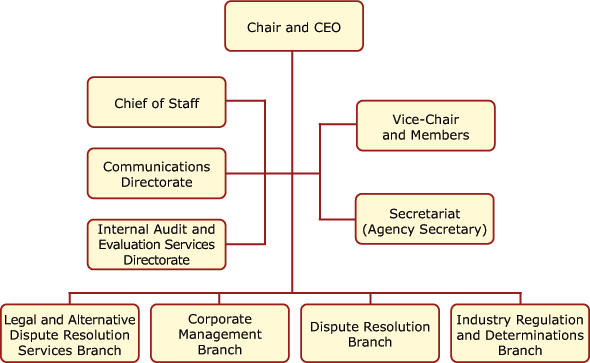
The Agency's headquarters are located in the National Capital Region. Agency personnel working in field offices in six cities across Canada carry out air and accessibility enforcement activities. More information about the role and the structure of the Agency can be found on its Web site at http://www.cta.gc.ca/eng/aboutus.
Parliament funds the Agency through an operating expenditures vote. The Agency operates within the context of the very large and complex Canadian transportation system (for details, refer to Transport Canada's Web site at http://www.tc.gc.ca).
Strategic Outcome and Program Activity Architecture
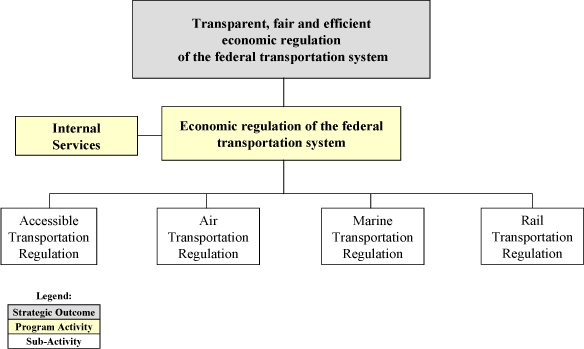
1.2 Performance Summary
Financial and Human Resources Information
The resources used in relation to the Strategic Outcome in fiscal year 2008–2009 are summarized in the following tables.
|
Planned Spending |
Total Authorities |
Actual Spending |
|---|---|---|
| 26,094 | 29,195 | 26,985 |
|
Planned |
Actual |
Difference |
|---|---|---|
| 251 | 223 | 28 |
|
Strategic Outcome 1: Transparent, fair and efficient economic regulation of the federal transportation system |
||
|---|---|---|
|
Performance Indicators |
Targets |
2008–2009 Performance Summary |
|
Feedback from users of, service providers within and others affected by the national transportation system on perceived transparency, fairness and efficiency of the decision-making process |
2008: Design survey |
Met |
| 2009: Conduct benchmark surveys and set targets | Will meet by 2009–2010 | |
| 2010: Conduct subsequent survey | Will meet by 2010–2011 | |
| Percentage of discretionary rulings overturned by the Federal Court of Appeal on basis of procedural fairness | 0% | 0% |
|
Percentage of cases resolved within prescribed time limits |
Disputes resolved formally: 65% resolved within 120 days | 56%[1] |
| Determinations: 95% issued within 120 days | 95% | |
| Licences: 85% issued within 14 days | 94% | |
| Charter permits: 92% issued within 30 days | 91% | |
| Mediation: 100% completed within 30 days (when no extension request) | 91% | |
|
Program Activity |
2007–2008 |
2008–2009 |
Alignment to Government of Canada Outcomes |
|||
|---|---|---|---|---|---|---|
|
Main Estimates |
Planned Spending |
Total Authorities |
Actual Spending |
|||
|
Economic regulation of the federal transportation system * |
25,491 | 26,094 | 26,094 | 29,195 | 26,985 |
The Agency's single program activity contributes to the Government of Canada's Outcome of “a fair and secure marketplace” |
* Includes contributions to employee benefit plans.
Explanation of variances
The planned spending for the Agency in 2008–2009 was $26.1 million; however, the Agency concluded the year with a revised authority to spend $29.2 million. The increase was due to an increase in appropriations for the 2007–2008 carry forward ($1.1 million), collective bargaining ($1.1 million) and the reimbursement of eligible pay list expenditures ($1.1 million) offset by a decrease in employee benefit plans ($0.2 million).
Overall, the Agency's total authorities in 2008–2009 were $29.2 million; however, the Agency concluded the year with actual spending of $27.0 million. The decrease of $2.2 million is due to:
- $1.1 million in operating carry forward to 2009–2010; and
- $1.1 million in operating funding that was not spent in 2008–2009.
Under-utilization of FTEs can be explained by the following:
- turnover;
- difficulty in finding qualified replacements because of low labour market availability for jobs being staffed; and
- delays in the staffing and classification process.
Contribution of Priorities to Strategic Outcome
In its 2008–2011 Strategic Plan, the Agency identified and pursued the following five priorities during 2008–2009:
|
Priority |
Type |
Performance Status |
|---|---|---|
|
Effective dispute resolution and economic regulation |
New | Partially attained and ongoing |
|
Focussing on people as its greatest asset |
New | Partially attained and ongoing |
|
Enhanced internal and external relations through clear and timely communications |
New | Partially attained and ongoing |
|
Accessible transportation network without undue obstacles to the mobility of persons |
New | Partially attained and ongoing |
|
Organizational support and responsiveness through superior management practices |
New |
Partially attained and ongoing |
A summary of the Agency's progress on these priorities during 2008–2009 is as follows:
Effective dispute resolution and economic regulation
- Successfully eliminated a significant backlog of dispute cases;
- Created a permanently staffed alternative dispute resolution service; and
- Improved the responsiveness and effectiveness with which disputes are resolved.
The Agency's people as its greatest asset
- Completed a gap analysis and identification of key positions and Agency vulnerabilities as part of succession planning;
- Initiated a knowledge transfer project;
- Expanded the Agency's investment in employee learning and training; and
- Created and maintained pools of qualified candidates through anticipatory staffing and succession planning.
Enhanced internal and external relations
- Launched a fully redesigned Agency Web site;
- Published Take Charge of your Travel, a new guide designed to help persons with disabilities when they travel;
- Developed a client satisfaction survey framework to be implemented beginning in 2009–2010; and
- Conducted an internal employee survey and held consultations on internal communications, including the Agency's intranet and awards and recognition program.
A more accessible transportation network
- Monitored the implementation by Air Canada, Jazz Air and WestJet of a one-person-one-fare policy for the domestic travel of persons with severe disabilities, as per its 2007–2008 decision; and
- Developed a new compliance monitoring framework designed to assess the extent to which transportation service providers are abiding by the Agency's accessibility regulations and Codes of Practice and to assist them where necessary in enhancing their compliance.
Organizational support and responsiveness
- Implemented a new organizational structure based on the Agency's two main functions: dispute resolution and economic regulation;
- Implemented a Performance Measurement Framework, began reporting on these indicators in this report and made significant progress in meeting the targeted performance levels; and
- Implemented a new Governance Framework for the Agency.
Risk Analysis
As a demand-driven organization with a mandate to serve Canadians in respect to transportation issues, the Agency's operations are affected by the external environment, government policies and the legislation. Significant changes in these areas have an impact on the Agency's ability to respond quickly to meet client and stakeholder expectations, due to its limited resources and capacity. Where possible, the Agency offers facilitation and mediation as alternatives to its formal process. These alternatives allow parties to resolve their issues in an informal manner that is faster, less litigious and less costly to all parties than the Agency's traditional decision-making process. The Agency has created a permanently staffed alternative dispute resolution service to continue promotion of and deal with the increased demand for this method of dispute resolution.
The Agency's mandate and responsibilities were recently expanded as a result of the passage of Bills C-8 and C-11 that imposed additional responsibilities on the Agency. The full impact of these changes on the current workload is still unknown; however, the Agency remains proactive in monitoring and addressing any changes in resource requirements.
These increased pressures — new responsibilities, greater demands, more complex cases, fewer resources — led the Agency to embark on a process of organizational renewal. The central aim of this process was to ensure that the Agency is able to adapt to an ever-changing environment by increasing flexibility and shifting resources where they are needed most. Adopting a more flexible approach enables the Agency to make the best use of its people, knowledge and expertise better manage risks and priorities.
A key component of the Agency's renewal was the implementation of a new organizational structure, which took effect on April 1, 2008. With this new structure, the Agency is now in a better position to manage workloads, respond to complex cases quickly and adapt to ongoing changes in its operating environment. The new organizational structure is intended to address challenges faced by the Agency through improving process efficiency. This ensures optimum use and realignment of resources that will match priorities and workload to meet these challenges.
The changing demographics of the Public Service workforce, and of the Agency in particular, present a significant human resource management challenge. The Agency is at risk of losing significant and unique corporate knowledge and expertise over the next few years as it faces retirements of long-term key employees. The retention of knowledge and expertise is critical to maintaining the level of service already provided, as well as adapting to additional responsibilities.
The Agency fully embraces the principle that employees are the greatest asset of any organization. It also recognizes that to attract and retain highly skilled individuals, they must be provided with a working environment that fosters innovation, develops talent and creates opportunities for employee development. The Agency continues to focus its efforts on recruiting, retaining and developing highly competent staff with the capabilities to ensure that there is a transfer of this knowledge and expertise to support the Agency's mandate. Areas where the Agency is most vulnerable to loss of business critical knowledge have been identified and are being addressed through various policies and corporate initiatives such as staffing pools of qualified candidates, targeted knowledge transfer initiatives, succession planning, continuous learning programs and in-house language training.
A new Governance Framework and significant changes to committee structures have ensured that the Agency is now equipped with a comprehensive and integrated model for management.[2] It is designed to help the Agency meet the objectives and priorities set out in its three-year Strategic Plan. Under this new Framework, the Executive Committee continues to set the governance and corporate strategic direction for the Agency, approve policies, budgets, operational plans and the Program Activity Architecture as well as monitor overall organizational performance. This Governance Framework has been established to specifically address the implementation of the Strategic Plan and to involve and engage employees at all levels. One of the key responsibilities of committee members is to keep employees informed and engaged on key developments arising from the work of these committees.
The Agency continued to integrate risk management into its strategic planning process and encourages effective risk management. Course corrections were made based on risk management performance and new information. For instance, the Agency considered the impact on its workload and resource requirements when new legislation imposed additional responsibilities. Associated resource requirements are based on forecasts and are continuously monitored through the Agency committees. The Agency adopted a more proactive and integrated approach to planning through the development of its three-year Strategic Plan[3] and detailed action plan. These plans will continue to serve as the mitigation strategies for 2008–2011.
While it is difficult to predict potential changes to its environment, the Agency must remain vigilant and proactive in order to adapt to any changes that significantly impact its service delivery. This is accomplished through enhanced communication and dialogue with stakeholders (clients, federal government partners, Parliamentarians and issue-focussed groups), allowing the Agency the opportunity to address and adapt internally and ensure sufficient resources (both financial and human) are properly in place.
Expenditure Profile
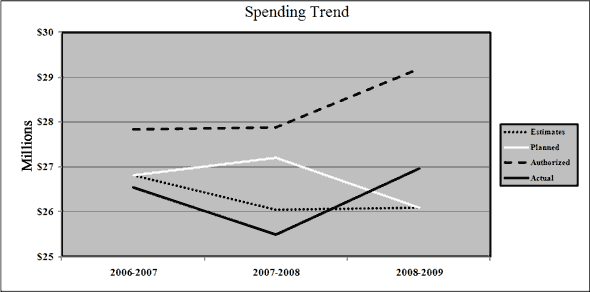
Link to the Government of Canada Outcome Areas
The Agency's Strategic Outcome and Program Activity are directly aligned with the broader Government of Canada Strategic Outcome of a fair and secure marketplace. The regulatory programs the Agency implements are designed to resolve economic issues, to remove transportation barriers and to protect the rights of consumers, carriers and other interested parties. These programs help improve the overall quality of life in Canada, as an efficient and accessible transportation system benefits all Canadians.
The Agency is one of many players involved in transportation and it maintains close ties with its various co-delivery partners, including Transport Canada, the Department of Foreign Affairs and International Trade, the Canada Border Services Agency and the Canadian Human Rights Commission. For details on these relationships, refer to the Agency's Web site at http://www.cta.gc.ca/about-nous/partners_e.html.
Voted and Statutory Items
|
Vote # or Statutory Item |
Truncated Vote or Statutory Wording |
2006–2007 |
2007–2008 |
2008–2009 |
2008–2009 |
|---|---|---|---|---|---|
|
Canadian Transportation Agency |
|||||
|
25 |
Operating expenditures |
23,289 | 22,423 | 22,803 | 23,919 |
|
(S) |
Spending of proceeds from the disposal of surplus Crown assets |
65 | 0 | 0 | 17 |
|
(S) |
Contributions to employee benefit plans |
3,197 | 3,069 | 3,291 | 3,049 |
|
Total |
26,551 | 25,492 | 26,094 | 26,985 |
Section II: Analysis of Program Activity by Strategic Outcome
2.1 Analysis of Program Activity by Strategic Outcome
The Agency is both an economic regulator and a quasi-judicial tribunal. It regulates the national transportation system (air, rail and marine) through the administration of laws, regulations, voluntary Codes of Practice, and education and outreach programs. It adjudicates disputes between users of, service providers within and others affected by the national transportation system.
As a regulator, the Agency has a mandate to administer the economic regulatory provisions affecting all modes of transportation under federal jurisdiction found in various Acts of Parliament. In 2008–2009, the Agency:
- issued approximately 2,400 discretionary and administrative rulings to support the effective regulation of the federal transportation system;
- after reviewing compliance with the air licensing requirements, processed 1,038 air licensing activities, including applications for new licences as well as suspensions, cancellations and reinstatements;
- issued 1,215 charter permits;
- participated in the negotiation of a comprehensive agreement for air services between Canada and all 27 European Union member states, and participated in the negotiation of an “Open-Skies” agreement with the Dominican Republic as well as expanded or new agreements with the Philippines and Panama;
- issued one new certificate of fitness to a railway, approved five variations to existing certificates in order to reflect changes in railway operations and processed two cancellations;
- determined that both the Canadian National Railway Company (CN) and the Canadian Pacific Railway Company (CP) had exceeded their revenue entitlement under the revenue cap regime for Western grain by $25,961,880 and $33,806,200 respectively. The carriers were ordered to pay the excess amounts, as well as a penalty totalling $3,894,282 for CN and $5,070,930 for CP, to be paid to the Western Grains Research Foundation. This is the largest amount by which any railway company has ever exceeded its revenue cap, and only the second time that both railway companies were above their caps in the same year[4];
- considered 135 coasting trade applications to protect the interests of the Canadian marine industry and allow foreign ships when no suitable Canadian ships are available; and
- undertook 360 inspections resulting in the issuing of 89 informal warnings, 13 formal warnings and seven notices of violation.
As an adjudicator, the Agency resolves transportation issues within the federal transportation system either by investigating and making formal tribunal decisions on complaints and ordering corrective measures as required, or by helping parties resolve their issues through the alternate dispute resolution processes of mediation or facilitation. In 2008–2009, the Agency:
- implemented measures to improve service levels, as resolving more complex complaints within the targeted 120 days continued to pose a significant challenge;
- resolved 757 dispute cases of which, 655 were through facilitation, 22 through mediation and 80 through decisions issued as a result of formal adjudication;
- was involved in 108 accessibility cases;
- released its final decision regarding the mobility of persons who require medical oxygen to travel by air;
- monitored the implementation of the 2007–2008 one-person-one-fare decision;
- processed 1,209 air travel complaints;
- redesigned the way it will capture and measure client feedback regarding the facilitated air travel complaints process;
- published its Guidelines for the Resolution of Complaints Concerning Railway Noise and Vibration;
- was involved in 31 environmental assessment processes for proposed rail line construction, road and utility crossing projects; and
- processed 127 agreements filed by parties that had successfully conducted their own negotiations related to rail crossings.
|
Strategic Outcome 1: Transparent, fair and efficient economic regulation of the federal transportation system |
|
Program Activity: Economic regulation of the federal transportation system |
|
Expected Result: Access to a specialized tribunal that is designed to serve the needs of users of, service providers within and others affected by the national transportation system |
|
2008–2009 Financial Resources |
2008–2009 Human Resources |
||||
|---|---|---|---|---|---|
|
Planned Spending |
Total Authorities |
Actual Spending |
Planned |
Actual |
Difference |
| 26,094 | 29,195 | 26,985 | 251 | 223 | 28 |
|
Program Description and Results: Economic regulation of air, rail and marine transportation through the administration of laws, regulations, voluntary Codes of Practice, and educational and outreach programs, and through the resolution of disputes. As an independent quasi-judicial administrative tribunal reporting to the Parliament of Canada through the Minister of Transport, the Canadian Transportation Agency makes its decisions independently, on a wide range of matters affecting Canadian transportation. |
|
Performance Indicator |
Target |
Target Date |
Performance Status |
|---|---|---|---|
|
Measures of satisfaction with Agency services related to serving the needs of users of, service providers within and others affected by the national transportation system |
2008: Design survey | 2008–2009 | Successfully met |
| 2009: Conduct benchmark surveys and set targets | 2009–2010 | Will meet | |
| 2010: Conduct subsequent surveys | 2010–2011 | Will meet |
The Agency's program activity is delivered via four program sub-activities — air transportation, rail transportation, marine transportation and accessible transportation — which are discussed in more detail below.
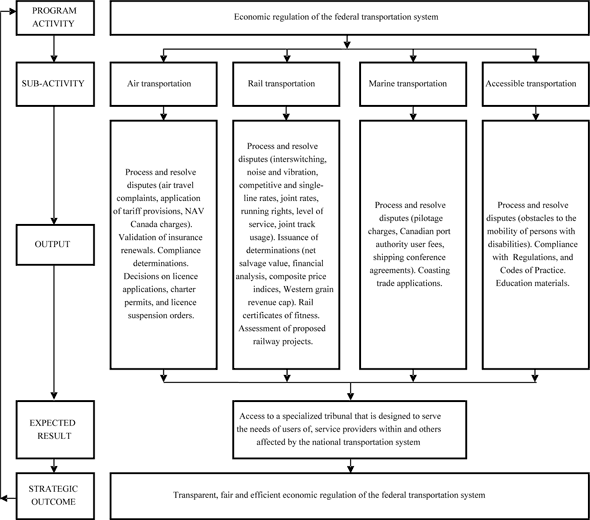
Air Transportation
Several amendments to the Air Transportation Regulations were made in 2009 to reflect legislative changes as a result of Bill C-11, An Act to amend the Canada Transportation Act and the Railway Safety Act and to make consequential amendments to other Acts (2007), receiving Royal Assent.
Specifically, changes were made to reflect the new requirement for air carriers flying to and from Canada, and who sell transportation through their Web sites, to post their terms and conditions of carriage on these same Web sites. Additionally, signage requirements for domestic and international carriers were harmonized. The revised regulations are now in effect.
In order to respond to concerns about the clarity and completeness of tariffs, the Agency is creating “model tariffs,” which clearly set out the format and tone to be used — and highlight the importance of making the terms and conditions of carriage understandable to Canadians. In 2008–2009, to encourage air carriers to simplify the terms and conditions found in their tariffs, the Agency began drafting best practices for tariff provisions.
|
2008–2009 Financial Resources |
2008–2009 Human Resources |
||||
|---|---|---|---|---|---|
|
Planned Spending |
Total Authorities |
Actual Spending |
Planned |
Actual |
Difference |
| 8,012 | 8,964 | 9,008 | 83 | 84 | (1) |
Description and expected results
Economic regulation
- licensing air carriers that provide domestic or international publicly available air transportation services to ensure that carriers hold liability insurance and a valid Canadian aviation document, and that Canadian carriers are owned and controlled by Canadian citizens;
- administering a permit system for international charter operations to protect Canadian originating international passenger charter flight advance payments;
- participating in negotiation of international air transport agreements and administration and implementation of these international air transport agreements;
- administering an enforcement program (through periodical inspections and investigations on alleged violations) to ensure ongoing compliance with the provisions of the Canada Transportation Act, the Air Transportation Regulations and the Personnel Training for the Assistance of Persons with Disabilities Regulations, as they apply to publicly available air carriers and other transportation service providers;
- leading Canadian participation in International Civil Aviation Organization facilitation activities;
- processing applications for extra-bilateral air services and approving cooperative arrangements such as leasing and code-sharing; and
- administering international air tariffs to ensure that bilateral agreements are respected, while balancing the interests of all parties.
Dispute resolution
- resolving complaints related to carriers' application of their tariff provisions and on prices applied by air carriers on non-competitive routes within Canada to ensure that air carriers licensed to operate in Canada meet the legislative requirements in place to protect Canadians; and
- ruling on appeals of new or revised air navigational charges imposed by NAV CANADA to ensure that principles used to establish them comply with the legislation.
|
Expected Results |
Indicator |
Target |
Target Date |
Performance Status |
|---|---|---|---|---|
|
Regulatory authorities required to operate publicly available air services are issued on a timely basis upon meeting the regulatory requirements |
Percentage of licences and charter permits issued prior to specified timelines |
92% of charter permits issued within 30 days | 2008 | 91% |
| 85% of licences issued within 14 days | 2011 | 94% | ||
|
Compliance with the Canada Transportation Act and its attendant regulations by licensees and by persons subject to the Personnel Training Regulations |
Percentage of inspections in which full compliance was identified |
100% compliance with the requirements to hold a valid licence, insurance and Air Operator Certificate | 2008 | 100% |
| 85% compliance with all other requirements of the Act and regulations | 2008 | 72% | ||
|
The Agency efficiently resolves complaints on air services, weighing the evidence submitted by the parties in a fair and reasonable manner [5] |
Percentage of disputes resolved formally within 120 days |
70% | 2011 | 61% |
|
Percentage of disputes resolved informally within 90 days |
80% | 2011 | 67% |
Rail Transportation
After extensive consultations, the Agency published its Guidelines for the Resolution of Complaints Concerning Railway Noise and Vibration. Developed to assist individuals, municipalities, railway companies and other parties in resolving these types of disputes, the Guidelines clearly explain:
- what collaborative measures parties must follow before the Agency investigates a complaint;
- what elements are considered in determining whether railway construction or operations have caused only such noise and vibration as is reasonable; and
- how to file a complaint, what information must be submitted, as well as the process to be followed.
The guidelines require parties to a rail noise or vibration issue to engage in a meaningful dialogue in an effort to explore available solutions in a constructive manner prior to coming to the Agency with a formal complaint. A newly formed technical advisory committee will provide expert advice to the Agency on an ongoing basis.
Federally regulated railway companies use the Uniform Classification of Accounts (UCA) to report their operating expenses, revenues and other statistics, while the costing regulations set out the items and factors for making railway costing determinations, including cost of capital and depreciation. A comprehensive, two-phase technical review by the Agency of the UCA is underway. Phase one of this review was completed in February 2009, while phase two was officially launched in January 2009. The Agency also intends to initiate a review of the Railway Costing Regulations to bring them up to date.
|
2008–2009 Financial Resources |
2008–2009 Human Resources |
||||
|---|---|---|---|---|---|
|
Planned Spending |
Total Authorities |
Actual Spending |
Planned |
Actual |
Difference |
| 5,615 | 6,221 | 4,814 | 51 | 41 | 10 |
Description and expected results
Economic regulation
- making fair and reasonable determinations of the Canadian National Railway Company (CN) and the Canadian Pacific Railway Company (CP) unit costs and price indices, for use in the development of interswitching rates and other regulatory cost applications;
- making an independent and fair assessment of the annual revenue caps for CN and CP for the movement of Western grain to ensure the railway companies have not exceeded their revenue entitlement for the movement of Western grain;
- making fair and reasonable determinations of the net salvage values of railway lines advertised for discontinuance and sale, as requested by at least one of the parties to the purchase transaction;
- issuing rail certificates of fitness to federally regulated rail carriers to ensure that they hold adequate third-party liability insurance; and
- assessing the environmental, operational, social and other impacts of proposed railway construction projects and ordering corrective measures as required to ensure the requirements of the Canadian Environmental Assessment Act and the interests of communities affected by the proposed lines are taken into account.
Dispute resolution
- resolving disputes between shippers and rail carriers regarding issues such as: interswitching, competitive or single line rates; joint rates; running rights; joint track usage; and level of service to ensure that shippers have access to alternative railways, adequate level of service and reasonable rates; and
- resolving disputes between railway companies and municipalities, road authorities, landowners and others that interact with them to ensure a balance between parties and a lower-cost, more efficient process to resolve disputes.
|
Expected Results |
Indicator |
Target |
Target Date |
Performance Status |
|---|---|---|---|---|
|
The Agency efficiently balances the interests of shippers, farmers, landowners, road authorities, utility companies, all levels of government and railway companies in a commercially fair and reasonable manner |
Percentage of disputes resolved formally within 120 days |
75% | 2011 | 55% |
|
Environmental, economic and social impacts of railway construction projects, railway lines and yards are mitigated |
Percentage compliance with prescribed mitigation conditions as determined on follow-up |
100% | 2008 | No applications for projects requiring mitigation conditions were received |
Marine Transportation
The Agency is responsible for determining if Canadian or non-duty ships are suitable and available to operate commercial services proposed to be operated by foreign ships in Canadian waters. Once the Agency has determined that no Canadian or non-duty ship is suitable and available for the proposed service, it is the responsibility of the Minister of Public Safety and Emergency Preparedness to issue the licence. In 2008–2009, the Agency considered 135 coasting trade applications.
A review of the Agency's coasting trade guidelines was started in 2008–2009, with expected completion in 2009–2010. Updated guidelines will further clarify the Agency's expectations with regards to coasting trade applications. To streamline the coasting trade application process, the Agency is currently implementing an online and e-mail application notification system, as well as creating a subscription-based contact list. These new measures will allow the Agency to continue to provide efficient service and meet its performance target for processing coasting trade applications.
In 2008–2009, tariff proposals or amendments were published by the country's four pilotage authorities:
- the Great Lakes Pilotage Authority;
- the Atlantic Pilotage Authority;
- the Pacific Pilotage Authority; and
- the Laurentian Pilotage Authority.
The Agency did not receive objections to these tariff changes.
No complaints were filed with the Agency in 2008–2009 regarding fees set by port authorities.
|
2008–2009 Financial Resources |
2008–2009 Human Resources (FTEs) | ||||
|---|---|---|---|---|---|
|
Planned Spending |
Total Authorities |
Actual Spending |
Planned |
Actual |
Difference |
| 871 | 975 | 805 | 8 | 5 | 3 |
Description and expected results
Economic regulation
- determining if Canadian or non duty-paid ships are suitable and available to operate commercial services proposed to be provided by foreign ships upon request by a resident of Canada to ensure that no foreign ships will be allowed to operate such services if a Canadian or non-duty paid ship is available.
Dispute resolution
- resolving complaints about user fees charged by Canadian port authorities, the St. Lawrence Seaway Management Corporation and the Federal Bridge Corporation to determine if they are unjustly discriminatory;
- resolving complaints that shipping conference agreements or actions by a member of a cartel of shipping lines substantially reduces competition and results in an unreasonable increase in price or a reduction in service; and
- ruling on objections to proposed pilotage charges to determine whether the pilotage authority has based its fees to continue operations on a self-sustaining financial basis, and if the proposed user charges are fair, reasonable and in the public interest.
|
Expected Results |
Indicator |
Target |
Target Date |
Performance Status |
|---|---|---|---|---|
|
The Agency efficiently determines that pilotage charges are in the public interest and that port fees and seaway tolls are not unjustly discriminatory |
Percentage of disputes resolved formally within 120 days |
70% | 2008 | 100% |
|
The Agency efficiently protects the interests of operators of Canadian registered ships while allowing access to foreign ships when suitable Canadian registered ships are not available |
Percentage of applications processed prior to the specified deadline |
95% prior to commencement date when no offer is made | 2008 | 100% |
| 80% issued within 90 days when offer is made | 2011 | 100% |
Accessible transportation
In 2008–2009, a significant backlog of accessibility cases was closed, which has contributed to the Agency's substantial progress in meeting its performance targets on the resolution of accessibility disputes. The Agency is now well on its way to meeting these goals.
That being said, the issues raised in accessibility cases are often highly complex and have wide-ranging implications for stakeholders. This complexity, along with the in-depth analyses required, can have a significant impact on the length of time required to issue fair and reasonable rulings.
On June 26, 2008, the Agency released its final decision on 25 complaints against Air Canada and one complaint against WestJet regarding the mobility of persons who require medical oxygen to travel by air.[6] In its decision, the Agency determined that passenger-supplied oxygen, in whatever form permitted by safety and security regulations, is the most appropriate accommodation.
In another matter, following unsuccessful attempts to appeal the Agency's decision to the Federal Court of Appeal and the Supreme Court of Canada, Air Canada, Jazz Air and WestJet implemented a one-person-one-fare policy for persons with severe disabilities who travel within Canada as required by January 10, 2009.[7] The decision means that, for domestic services, the airlines may not charge more than one fare for persons with disabilities who:
- are accompanied by an attendant for their personal care or safety in flight, as required by the carriers' domestic tariffs; or
- require additional seating for themselves, including those determined to be functionally disabled by obesity for purposes of travel.
The Agency's five voluntary Codes of Practice on accessibility and regulations on the carriage of persons with disabilities are now supported by a new monitoring framework intended to foster greater industry compliance with their provisions. Extensive outreach and educational initiatives continue to be an integral part of the framework, as they help parties to know their rights and responsibilities regarding accessibility.
The meeting of the Agency's Accessibility Advisory Committee, held in March 2009, brought together members of the transportation industry with groups representing persons with disabilities.
|
2008–2009 Financial Resources |
2008–2009 Human Resources |
||||
|---|---|---|---|---|---|
|
Planned Spending |
Total Authorities |
Actual Spending |
Planned |
Actual |
Difference |
| 2,171 | 2,429 | 2,443 | 19 | 20 | (1) |
Description and expected results
- resolving complaints, promulgating regulations, developing Codes of Practice and standards concerning the level of accessibility in modes of transportation under federal jurisdiction, and communicating with the transportation industry and the community to ensure that the federal transportation network is accessible to persons with disabilities by removing undue obstacles to their mobility, and to increase awareness about industry and consumer rights and obligations.
|
Expected Result |
Indicator |
Target |
Target Date |
Performance Status[8] |
|---|---|---|---|---|
|
The Agency efficiently resolves complaints about obstacles to the mobility of persons with disabilities, weighing the interests of persons with disabilities with those of the industry in assessing whether the obstacle is undue |
Disputes resolved formally within 120 days |
50% | 2011 | 33% |
More information about the Agency's accessible transportation program can be found in the Annual Report for 2008–2009 available on the Agency's Web site at http://www.cta.gc.ca/eng/annual-reports and in the Accessible Transportation section of the Web site.
Internal Services
Internal Services refers to both the corporate functions that support the delivery of the Agency's plans and priorities as well as the specialized tribunal services that are an integral part of the delivery of the operational mandate of the Agency.
|
2008–2009 Financial Resources |
2008–2009 Human Resources |
||||
|---|---|---|---|---|---|
|
Planned Spending |
Total Authorities |
Actual Spending |
Planned |
Actual |
Difference |
| 9,425 | 10,606 | 9,915 | 90 | 73 | 17 |
Description
Corporate functions
- develops, maintains and implements integrated systems, policies, procedures, services, strategic planning and internal audit for the effective acquisition and stewardship of financial and material resources;
- provides effective and timely human resources services and advice to managers, employees and unions;
- provides advice and support regarding internal and external strategies, activities and products in order to effectively meet the information needs of our clients and stakeholders; and
- provides advice and support on the management and use of information and technology;
Specialized tribunal services
- provides legal advice and counsel;
- provides editing, translation and quality control services for Agency proceedings; and
- provides registrar services and coordinates ministerial correspondence.
Results
Succession plan
- Gap analysis and identification of key positions and Agency vulnerabilities completed in 2008
- Ensure that recruitment strategy and knowledge management activities address vulnerabilities in 2009–2010
Recruitment strategy
- Agency Student Employment Program launched in March 2009
- Pools of qualified candidates created through selection processes in 2008–2009 used to fill vacancies
- Approach for proactive use of resourcing pools to be developed in 2009
Knowledge management strategy
- Generic competencies updated for all positions
- Pilot projects on knowledge management conducted in 2008–2009 to identify best practices
Operational plans integrate multi-year budgeting and planning into resource management allocations
- Three-year budgeting and strategic planning process was
introduced incorporating the following into Agency
operational plans:
- Performance measures and reporting
- Human resource and information management and technology planning
- Risk management
Internet site
- New Agency Web site was launched
Communications
- The Agency conducted an internal communications survey
- Consultations were held to expand upon and refine ideas generated by the survey
- The survey and the consultations provided innovative ideas that will help shape the Agency's approach to internal communications, as well as the development of a new intranet site
Benefits for Canadians
In exercising its court-like powers, the Agency employs processes that are responsive, fair and transparent, and considers the interests of all parties to disputes involving the national transportation system. Its adjudicative formal decision-making process is governed by the rules of natural justice and fairness.
Through its actions and by working closely with Transport Canada, other departments, its clients and stakeholder groups, the Agency supports the goal of a Canadian transportation system that is competitive, efficient and accessible — and that meets the needs of those who provide or use transportation services.
Section III: Supplementary Information
3.1 Financial Highlights
The Agency's financial statements can be found on the Agency's Web site at www.cta.gc.ca/eng/financial-statement-08-09.
|
% Change |
2009 |
2008 |
|
|---|---|---|---|
|
ASSETS |
-3.6% |
3,125 |
3,242 |
|
TOTAL |
-3.6% | 3,125 | 3,242 |
|
LIABILITIES |
+22.3% | 7,435 | 6,077 |
|
EQUITY |
-52.0% | (4,310) | (2,835) |
|
TOTAL |
-3.6% | 3,125 | 3,242 |
|
% Change |
2009 |
2008 |
|
|---|---|---|---|
|
Expenses |
+11.7% | 31,226 | 27,962 |
|
Revenues |
+135.5% | 73 | 31 |
|
Net Cost of Operations |
+11.5% | 31,153 | 27,931 |
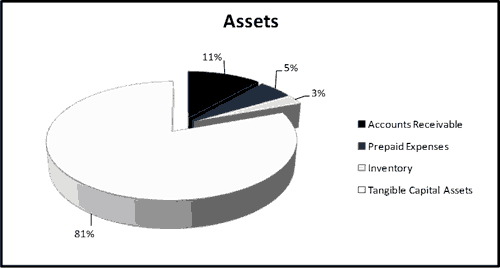
Total assets were $3.1 million at the end of 2008–2009, a decrease of $0.1 million (3.6%) over the previous year's total assets of $3.2 million. Tangible capital assets represented $2.5 million (81%), accounts receivable represented $0.4 million (11%), while prepaid expenses and inventory represented 5% and 3% respectively of total assets.
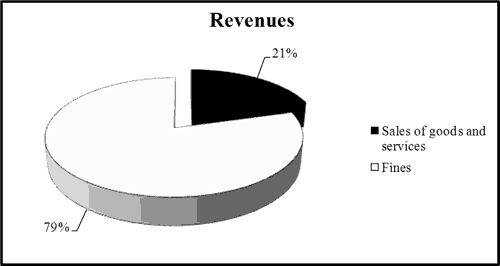
The Agency's total revenues amounted to $73,469 for 2008–2009. There was a large increase of $42,286 (135.5%) from the previous year's revenue due to an increase in penalties. Almost all of the Agency's revenue is derived from two sources: penalties (fines) imposed on air carriers and transportation facilities ($58,115), and determining the net salvage value of railway assets during the discontinuance of a railway line ($15,030). All other levels of revenue were marginal for 2008–2009.
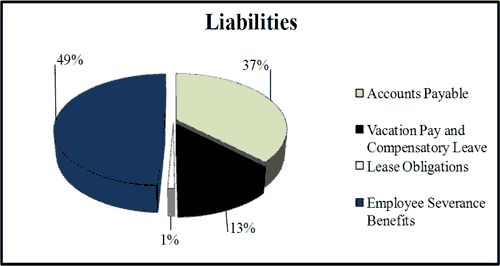
Total liabilities were $7.4 million at the end of 2008–2009, an increase of $1.3 million (22.3%) over the previous year's total liabilities of $6.1 million. Employee severance benefits and accounts payable represented the largest portion of total liabilities at $3.7 million and $2.7 million respectively.
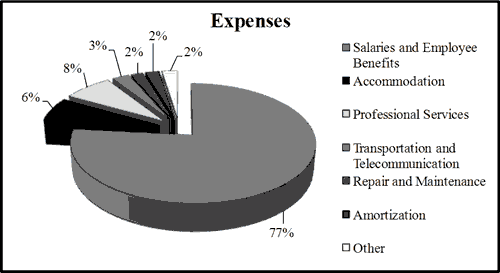
The Agency's total expenses were $31.2 million in 2008–2009. The majority of funds, $24 million or 77%, were spent on salaries and employee benefits, 8% on professional services, 6% on accommodation and the remaining 9% going towards repair and maintenance, rentals, materials and supplies, machinery and equipment.
3.2 List of Supplementary Information Tables
All electronic supplementary information tables found in the 2008–2009 Departmental Performance Report can be found on the Treasury Board of Canada Secretariat's website at: http://www.tbs-sct.gc.ca/dpr-rmr/2008-2009/index-eng.asp.
Sources of Respendable and Non-Respendable Revenue
User Fees/External Fees
Response to Parliamentary Committees and External Audits
Internal Audits and Evaluations
3.3 Other Items of Interest
Annual Reports
Annual Reports for 1997 to 2009 are available on the Agency's Web site at http://www.cta.gc.ca/eng/annual-reports.
Contacts for Further Information
Postal address:
Canadian Transportation Agency
Ottawa, Ontario, Canada K1A 0N9
Web site:
http://www.cta.gc.ca
|
Area of Responsibility |
Contact Name |
Title |
Telephone Number and E-mail Address |
|
Legal |
Claude Jacques |
General Counsel |
819-997-9323 |
|
Dispute Resolution (Air, Rail, Marine and Accessible Transportation) |
Joan MacDonald |
Director General |
819-953-5074 |
|
Industry Regulation and Determinations (Air, Rail and Marine Transportation) |
Ghislain Blanchard |
Director General |
819-953-4657 |
|
Corporate Management |
Arun Thangaraj |
Director General |
819-997-6764 |
|
Finance, Administration and Planning |
Michel LeBlanc |
Director |
819-953-2829 |
|
Communications |
Jacqueline Bannister |
Director |
819-953-7666 |
Legislation and Regulations
|
Canada Transportation Act |
S.C., 1996, c. 10, as amended |
|
Access to Information Act |
R.S.C., 1985, c. A-1 |
|
Canada Marine Act |
S.C., 1998, c. 10 |
|
Canadian Environmental Assessment Act |
S.C., 1992, c. 37 |
|
Civil Air Navigation Services Commercialization Act |
S.C., 1996, c. 20 |
|
Coasting Trade Act |
S.C., 1992, c. 31 |
|
Energy Supplies Emergency Act |
R.S.C., 1985, c. E-9 |
|
Financial Administration Act |
R.S.C., 1985, c. F-11 |
|
Official Languages Act |
R.S.C, 1985, c. 31 (4th Supp.) |
|
Pilotage Act |
R.S.C., 1985, c. P-14 |
|
Privacy Act |
R.S.C., 1985, c. P-21 |
|
Public Service Modernization Act |
S.C., 2003, c. 22 |
|
Railway Relocation and Crossing Act |
R.S.C., 1985, c. R-4 |
|
Railway Safety Act |
R.S.C., 1985, c. 32 (4th Supp.) |
|
Shipping Conferences Exemption Act, 1987 |
R.S.C., 1985, c. 17 (3rd Supp.) |
The Agency has sole responsibility for the following regulations and other statutory instruments:
Air Transportation Regulations
Canadian Transportation Agency Designated Provisions Regulations
Canadian Transportation Agency General Rules
Personnel Training for the Assistance of Persons with Disabilities Regulations
Railway Costing Regulations
Railway Interswitching Regulations
Railway Third Party Liability Insurance Coverage Regulations
Railway Traffic and Passenger Tariffs Regulations
Railway Traffic Liability Regulations
Uniform Classification of Accounts and Related Railway Records
The Agency shares responsibility for the following regulations:
Carriers and Transportation and Grain Handling Undertakings Information Regulations
Railway Company Pay Out of Excess Revenue for the Movement of Grain Regulations
The Jacques-Cartier and Champlain Bridges Inc. Regulations
The Seaway International Bridge Corporation, Ltd. Regulations
These Acts and Regulations are available in the “Legislation” section of the Agency's Web site at http://www.cta.gc.ca/eng/laws-regulations
[1] In order to set a normalized initial benchmark for the measurement of Agency performance, a number of backlogged cases, primarily related to a major accessibility decision on access to medical oxygen when travelling by air, were not included in this calculation.
[2] The Governance Framework consists of three standing committees that report to the Agency's Executive Sub-Committee on People Strategic Priority: the Human Resources Management Committee, the Business Process Steering Committee and the Internal Communications and External Relations Committee.
[3] The Agency's Strategic Plan 2008–2011 can be found on the Agency's Web site: http://www.cta.gc.ca/eng/stratplan.
[4] To view this decision, refer to the Agency's Web site: http://www.otc-cta.gc.ca/decision-ruling/drv.php?id=28092&lang=eng.
[5] For more information regarding specific air disputes, refer to the Agency's 2008–2009 Annual Report. http://www.cta.gc.ca/eng/annual-reports.
[6] The decisions can be found on the Agency's Web site: http://www.otc-cta.gc.ca/decision-ruling/listes-lists.php?type=d&mm=6&aaaa_yyyy=2008&cat=AT&lang=eng.
[7] The decision can be found on the Agency's Web site: http://www.otc-cta.gc.ca/decision-ruling/drv.php?id=26872&lang=eng.
[8] In order to set a normalized initial benchmark for the measurement of Agency performance, a number of backlogged cases, primarily related to a major accessibility decision on access to medical oxygen when travelling by air, were not included in this calculation. For information on these cases, please refer to the 2008–2009 Annual Report at http://www.cta.gc.ca/eng/annual-reports